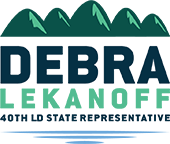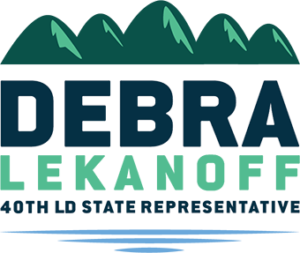The Drought in Washington on Fantastic Friday
Dear Friends,
This week I’m excited to bring you a special Fantastic Friday, focusing in on the current drought here in Washington, some of its impacts, and what we as Washingtonians can do to help.
However, I’d like to take a moment at the top of this newsletter to share with you an incredible podcast that featured a dear friend of mine – Gina McCarthy, the former Environmental Protection Agency Administrator!

Back in May, Gina was on Wiser Than Me with Julia Louis-Dreyfus, covering a wide range of topics from working as the only woman in the room, how to strategize and achieve your goals, and what we can do to energize people to address the ongoing climate crisis.
Gina was an early support of mine, and she endorsed me during my first campaign in 2018. I have long counted her as a close friend, and she has been a tremendous resource and mentor as I have served you in Olympia.
We have so much to learn from Gina’s breadth of experience, and I am so glad to have someone so passionate and capable working on behalf of our natural world.
If you want to listen to the podcast, click here.
Keep reading for more on this Fantastic Friday.
“Stay Safe, Stay Healthy”
Rep. Debra Lekanoff
Drought Emergency Declaration
Now, I want to turn our attention to the current drought impacting Washington.
On July 24, following early snowmelt, a lack of spring rain, and low streamflows, the Washington State Department of Ecology officially declared a drought emergency for 12 watersheds in parts of 12 counties.
Both Whatcom and Skagit county were included in the declaration, and the Nooksack River Basin is currently operating on emergency status.
About 350 water customers are affected, according to the Department of Ecology, and that number will only grow as this emergency unfolds.
It is up to us to do our part and help ease the situation – both by conserving water wherever possible, and taking concrete action to address environmental issues that are plaguing not only Washington, but the entire world.

According to the Department of Ecology:
“Counties affected by the drought declaration include Benton, Clallam, Columbia, Jefferson, Kittitas, Klickitat, Okanogan, Skagit, Snohomish, Walla Walla, Whatcom and Yakima. The rest of the state remains under the drought advisory issued by Ecology July 5.
In Washington, drought is declared when there is less than 75% of normal water supply and there is the risk of undue hardship. Declaring a drought emergency allows Ecology to process emergency water right permits and transfers. New legislation passed this spring also makes $3 million in emergency drought funds available as grants to support communities, irrigation districts, Tribes and other public entities facing hardships.”
This is an ongoing issue that has rippling impacts throughout our communities. Keep reading for more information on the drought, and if you would like to read more from the Department of Ecology, click here.
What Can We Do?
Next, I’d like to share some resources on what you can do to help mitigate the impacts of the drought here in the 40th LD.
There are a number of small things each of us can do, from using less water in the shower to not watering our lawns, but if you are interested in taking some additional steps then check out the resources put together by the Washington State Department of Health and Washington State University.
Find the Department of Health Resources here.
Washington State University Resources here.
This is a far reaching issue that will take significant action on a state, national, and international level to truly address. However, each of us can do our part to support the communities most heavily impacted by the drought.
Joint Legislative Committee on Water Supply During Drought
Earlier this summer, I told you about my recent appointment to the Joint Legislative Committee on Water Supply During Drought, an important group that is more important now than ever.
A week after the official drought emergency declaration, we met to receive updates from the Department of Ecology, the Office of the State Climatologist, the Department of Fish & Wildlife, the Kittias Reclamation District, and the Roza Irrigation District.
When a drought emergency order is in effect, Ecology must provide the Drought Committee with at least monthly reports describing drought response activities of Ecology and other state and federal agencies.

The Joint Legislative Committee on Water Supply During Drought consists of four senators and four representatives, convening when drought conditions exist, or are expected to come within the next year, in order to ensure that Washington’s water supply is used and sustained correctly.
It is an honor to be a part of this committee, and we are working nonstop to support those communities hit the hardest by the drought. I will continue to share updates and information as they become available to me.
What We Can Learn From the Past
Next, I want to take a moment and look back at the drought of 2015, a few reports that came out of the ordeal, and what we can learn moving forward.
In 2015, the Washington State Department of Ecology provided funds to the Washington State Department of Agricultural to conduct an assessment of the economic impacts brought about by the drought to the agricultural sector.

They looked at a variety of factors throughout the state, looking closely at certain regions that were estimated to have been hard.
According to the Department of Agriculture:
“This report estimated total $633-773 million gross revenue losses. The impacts of the 2015 drought were not limited to certain crops or regions and many of these impacts were not quantifiable in the scope of this study. Through this work, WSDA gained a better understanding of how variable drought impacts can be throughout the state.”
Read the full report here.
Also following the drought in 2015, Smithsonian Magazine published an article looking in depth at the impact that climate change and drought in the Northwest will have on our native aquatic populations.
According to Smithsonian Magazine:
“Warm water carries disease more easily and stressed fish used to cooler waters succumb to illness sooner. Young fish are especially vulnerable if they don’t swim from their hatching grounds to cool water quickly.
Cold water releases from dams and chillers at hatcheries are just two examples of ways people are trying to keep the water cool enough, but the problem is so massive it is hard to combat. Many of these fish populations are already struggling and don’t have the resilience they might have helped them ride out the drought conditions in the past.”

These looks into how we reacted eight years ago can tell us a lot, but above all else they are saying that this issue is here, it is happening, and we must address it.
We do not have time to look down the road or plan future action. We must prioritize supporting and restoring our environment today, so that our children tomorrow can enjoy the beauty of the world with their children in turn.
How Climate Change Impacts Our Salmon
As we stand witness to the increasing impacts of climate change around the world, there are mounting effects right here in Washington that need our attention.
One of those is the growing need to address climate change in order to save our native salmon population, who find their natural habitats increasingly threatened by the rising temperatures and shrinking glaciers.

The average annual air temperature in Washington rose by 1.77 degrees Fahrenheit between 1960 and 2020, with no signs of slowing down. As we continue to emit substantial amounts of greenhouse gases, we will only see the temperature rise, and the rate of change increase.
As the temperatures in Washington and around the world have risen, we are watching our glaciers shrink and mountain snowpack become smaller every year.
Our native salmon population return to Washington streams every year, expecting cold and plentiful water. Instead, as the glaciers and snowpack shrink, we are seeing smaller and smaller amounts of water that are warmer than the salmon expect.
Without direct action, we slowly ruin the natural habitat of this vital creature, reducing the overall population and the locations that they can call home.
This is just one of the many lasting and deep impacts of climate change that it is our responsibility to address. My work will always be founded on creating a world in which my grandchildren’s grandchildren can thrive, and that starts by making sure that the natural beauty if this world is protected.
[/et_pb_text][/et_pb_column][/et_pb_row][/et_pb_section]


